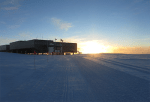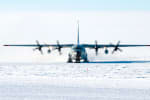It’s a bird, it’s a plane, it’s … no, wait, it’s just a plane. Actually, it’s a particular plane—a C-17, a large military transport aircraft—training for air drops over the South Pole station. […]
News
IceCube extends condolences on the passing of South Pole worker
The IceCube Collaboration is saddened to hear of the loss of Thomas Lawrence Atkins, a contract worker at NSF’s Amundsen-Scott South Pole Station. We greatly appreciate the sacrifice that contractors make to support science teams like ours at the South Pole. We extend our heartfelt condolences to Atkins’ family and friends at this difficult time. […]
Week 45 at the Pole
Last week, winterovers Erik and Stephan arrived, and this week Dag and Ian are leaving. Here they are, all four together out on the ice for the last time. […]
Week 44 at the Pole
Another summer season at the South Pole station means another changing of the guard for IceCube’s winterovers. This year’s Erik Beiser and Stephan Richter have arrived, two fresh faces ready to embark on their yearlong adventure, while Dag Larsen and Ian Rees, last year’s winterovers, made their final preparations for leaving the ice. […]
A new polar season for IceCube
After a long winter, South Pole inhabitants are getting used to the sunlight again. Up north, a bunch of IceCubers are getting ready for their Antarctic adventure. For some of them, it’s all about the excitement of a first trip to Antarctica. For some others, it’s an almost annual appointment that makes their job a special one. […]
Week 43 at the Pole
There’s a bit of prep work involved in getting the station ready for its summer opening. IceCube winterovers Ian and Dag used this time to perform an IceTop snow survey and to finish up snow removal around the ICL. […]
Week 42 at the Pole
For a place that receives so little precipitation, there’s an awful lot of snow around. So much snow that bulldozers are sometimes enlisted to move it out of the way, as shown here in front of this parked Basler aircraft. Planes can get stuck at the South Pole for days on end due to bad weather. And if high winds are part of that bad weather, then snow accumulation can be a problem. […]
Atmospheric neutrino oscillations measured with three years of IceCube data
Last year, an initial measurement of the neutrino oscillation parameters was a hint that IceCube could become an important detector for studying neutrino oscillations. Today, the IceCube Collaboration has submitted new results to Physical Review Letters that present an improved measurement of the oscillation parameters, via atmospheric muon neutrino disappearance, which is compatible and comparable in precision to those of dedicated oscillation experiments such as MINOS, T2K or Super-Kamiokande. […]
Week 41 at the Pole
After the sun’s arrival come the planes. The first of the season to reach the South Pole were a pair of Twin Otters, one of which appears parked in the accompanying image. Behind it is a Basler plane—a somewhat larger ski aircraft—shown just as it was landing, a few days later. […]
Week 40 at the Pole
Water restrictions prompt innovation. When already limited showers get rationed even further, as they have been recently at the South Pole station, you start thinking of ways to work around the problem. […]









